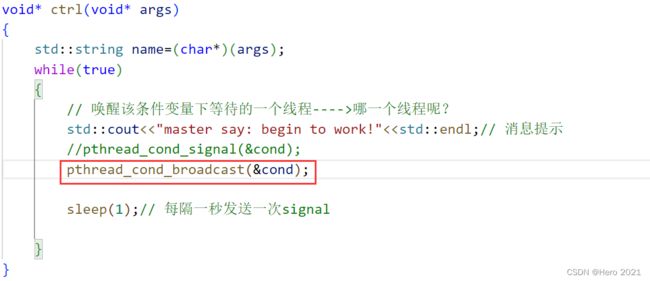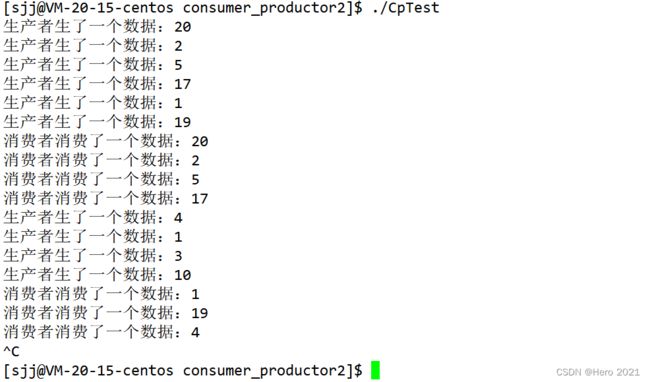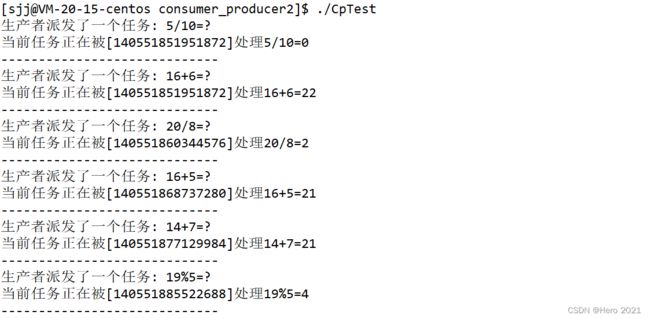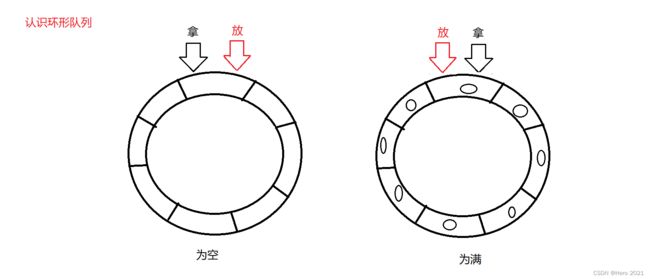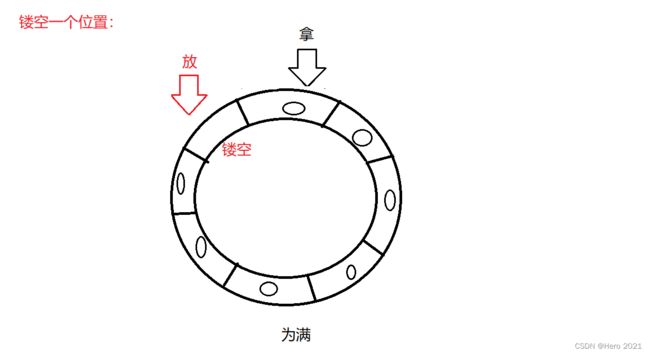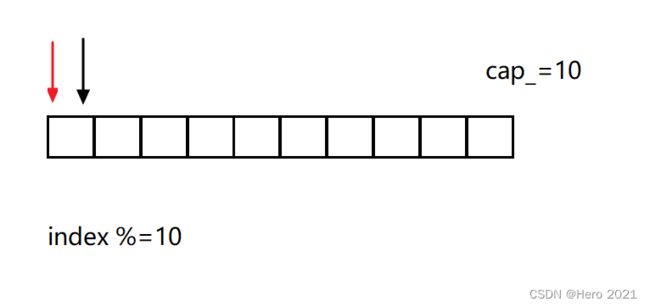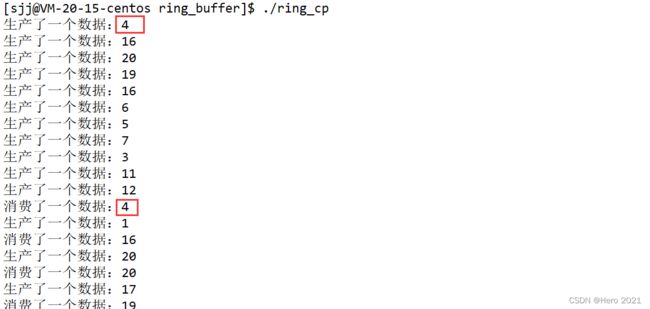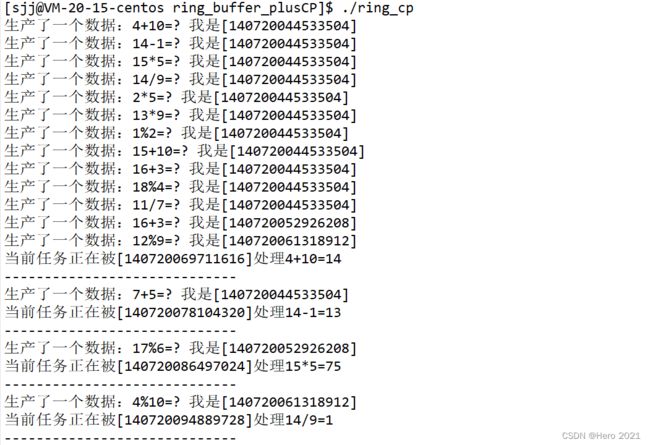Linux线程的同步与互斥(二) 条件变量+信号量
文章目录
- 二、线程同步
-
-
- 条件变量
-
- 1、条件变量的概念
- 2、同步概念与竞态条件
- 3、条件变量函数初始化
- 4、条件变量函数销毁
- 5、条件变量函数等待
- 6、条件变量函数唤醒等待
- 生产者消费者模型
-
- 1、理论部分
- 2、“3 2 1”原则
- 3、基于阻塞队列的生产者消费者模型
- POSIX信号量
-
- 1、信号量的概念
- 2、信号量操作函数
-
- ①初始化信号量
- ②销毁信号量
- ③等待信号量 P( )
- ④发布信号量 V( )
- 3、基于环形队列的生产者消费者模型
-
- ①认识环形队列
- ②多线程下的环形队列
- ③具体代码实现
- ④改进:改成多生产者、多消费者模型
-
二、线程同步
例如:当一个线程访问队列时,发现队列为空时只能等待,直到其他线程将一个节点添加到队列中,显然,只有互斥锁的情况下,我们比较困难的知道临界资源的状态,此时我们需要一种机制或者策略来知道临界资源的状态——条件变量!
条件变量
1、条件变量的概念
条件变量类似于if语句,他有“真”、“假”两个状态,在条件变量使用的过程中,一个线程等待条件为“真”,另一个线程在使用完临界资源后将条件设置为“真”,唤醒阻塞在等待条件变量为“真”的线程,执行其任务。在这个过程中,必须保证在并行或者并发的条件下使得条件变量在“真”“假”两个状态之间正确转换,所以条件变量一般需要和互斥锁配合使用,由此实现对于临界资源的互斥访问!
2、同步概念与竞态条件
- 同步:在保证数据安全的前提下,让线程能够按照某种特定的顺序访问临界资源,从而有效避免饥饿问题,叫做同步。
- 竞态条件:因为时序问题而导致程序异常,我们常称为竞态条件。在线程场景下,这种问题也不难理解。
3、条件变量函数初始化
如果你想要的创建条件变量,只需要在类中的或者全局创建一个pthread_cond_t类型的变量,这样原生线程库就会自动帮你创建好条件变量,然后你就可以开始一系列的操作。
| 函数名称 | pthread_cond_init |
|---|---|
| 函数功能 | 初始化条件变量 |
| 头文件 | #include |
| 函数原型 | int pthread_cond_init(pthread_cond_t *restrict cond, const pthread_condattr_t *restrict attr); |
| 参数 | cond:指向要初始化的条件变量的指针 attr:指向条件变量属性的指针,来指定条件变量的一些属性,但是我们这里给NULL,表明使用默认属性来初始化该条件变量 |
| 返回值 | 0:成功 !0:失败 |
4、条件变量函数销毁
| 函数名称 | pthread_cond_destroy |
|---|---|
| 函数功能 | 销毁条件变量 |
| 头文件 | #include |
| 函数原型 | int pthread_cond_destroy(pthread_cond_t *cond); |
| 参数 | cond:需要销毁的条件变量 |
| 返回值 | 0:成功 !0:失败 |
5、条件变量函数等待
| 函数名称 | pthread_cond_wait |
|---|---|
| 函数功能 | 等待条件变量被设置 |
| 头文件 | #include |
| 函数原型 | int pthread_cond_wait( pthread_cond_t *restrict cond, pthread_mutex_t *restrict mutex); |
| 参数 | cond:需要等待的条件变量 mutex:与条件变量相关的互斥锁 |
| 返回值 | 0:成功 !0:失败 |
6、条件变量函数唤醒等待
| 函数名称 | pthread_cond_signal |
|---|---|
| 函数功能 | 唤醒一个等待的线程 |
| 头文件 | #include |
| 函数原型 | int pthread_cond_signal(pthread_cond_t *cond); |
| 参数 | cond:需要通知的条件变量的指针 |
| 返回值 | 0:成功 !0:失败 |
问题:pthread_cond_signal等待的是哪一个线程?
在条件变量下的等待队列里等待的第一个线程!
| 函数名称 | pthread_cond_broadcast |
|---|---|
| 函数功能 | 唤醒所有等待的线程 |
| 头文件 | #include |
| 函数原型 | int pthread_cond_broadcast(pthread_cond_t *cond); |
| 参数 | cond:需要广播通知的条件变量的指针 |
| 返回值 | 0:成功 !0:失败 |
我们现在想要实现一个简单的逻辑,boss发出指令去控制工作线程工作:
#include 结果展示:

现象:老板发出命令,线程才开始工作,而且每个线程都是按序工作(2->1->0)。
当2号线程,1号线程他们跑完自己的任务,去干什么了?
答案:他又跑去当前条件变量下等待去了
结论:每个线程运行完后都去死循环等待了,条件变量内部一定存在一个等待队列。
生产者消费者模型
1、理论部分
超市——生产者消费者模型
主要有两大优点
- 提高效率
- 将生产环节与消费环节解耦
为什么要有超市?
收集需求,减少交易成本
2、“3 2 1”原则
- 3种关系
生产者与生产者:竞争、互斥关系
消费者与消费者:竞争、互斥关系
生产者与消费者:互斥、同步关系 - 2个角色
生产者与消费者,通常n :n - 1个交易场所
超市->(交易场所,通常就是一段缓冲区,可以是一段内存空间、STL容器等)
3、基于阻塞队列的生产者消费者模型
当前我们的策略:
1、当生产满时,就不要生产了(不要竞争锁了),而应该让消费者来消费
2、当消费空了,就不应该消费(不要竞争锁了),而应该让生产者来生产
所以我们的条件变量有两个:
template <class T>
class BlockQueue
{
private:
std::queue<T> bq_; // 阻塞队列
int cap_;
pthread_mutex_t mtx_; // 保护临界资源的锁
pthread_cond_t is_full_; // bq_满的,消费者在该条件变量下等待
pthread_cond_t is_empty; // bq_空的,生产者在该条件变量下等待
puulic:
// code
};
const &:输入型参数
*:输出型参数
&:输入输出型参数
void Push(const T &in)
{
LockQueue();
if (IsFull())
{
//等待会将线程挂起,且当前持有锁(别人来申请会造成死锁问题)
ProducterWait();
}
bq_.push(in);
if(bq_.size()>cap_/2)WakeupConsumer();
UnLockQueue();
//WakeupConsumer(); // 在内在外都可以
}
void Pop(T *out)
{
LockQueue();
if (IsEmpty())
{
//让消费者等待
ConsumerWait();
}
*out = bq_.front();
bq_.pop();
if(bq_.size()<cap_/2)WakeupProducter();
UnLockQueue();
//WakeupProducter();
}
pthread_cond_wait函数的功能:
1、调用时,会首先自动释放mtx_,然后再挂起自己!
2、返回时,会首先自动竞争锁,获得锁之后,才能返回!
void ProducerWait()
{
pthread_cond_wait(&is_empty_, &mtx_);
}
void ConsumerWait()
{
pthread_cond_wait(&is_full_, &mtx_);
}
下面我们来实现我们全部的生产消费逻辑代码:
#pragma once
#include 此处有个bug!!!!

使用if来进行条件判断是不太完善的!
如果出现了如图所示的两种情况,当函数ProducterWait返回时,那么if语句是默认顺序向下执行的,并不满足生产函数的条件,所以我们需要再次进行判断,将if换成while。
我们需要进行条件检测的时候,这里需要使用循环的方式,来保证退出循环一定是因为条件不满足导致的!
LockQueue();
// if (IsFull()) // bug?
while (IsEmpty())
{
// 条件不满足时,让生产线程等待
ProducerWait();
}
bq_.push(in);
if (bq_.size() > cap_ / 2)
WakeupConsumer(); // 只有生产者知道,消费者什么时候可以消费
UnlockQueue();
改进
生产和消费,传输数据只是第一步
我们还需要解决两个问题
1、数据怎么来的?耗时吗?
2、数据怎么处理?耗时吗?
所以我们还需要添加一个场景–>任务处理
// "task.hpp"
#pragma once
#include POSIX信号量
1、信号量的概念
信号量的本质是一把计数器,描述临界资源中资源数目的大小(最多能有多少资源分配给线程)
2、信号量操作函数
同样和互斥锁和条件变量的使用相同,需要定义一个sem_t类型的变量,就可以用户信号量的操作函数
①初始化信号量
int sem_init(sem_t *sem, int pshared, unsigned int value);
参数:
pshared:默认给0即可,0表示线程间共享 ,非0表示进行间共享
value:信号量的初值
②销毁信号量
int sem_destroy(sem_t *sem);
③等待信号量 P( )
int sem_wait(sem_t *sem);
④发布信号量 V( )
int sem_post(sem_t *sem);
3、基于环形队列的生产者消费者模型
①认识环形队列
问题:环形队列什么时候为空?什么时候为满?
刚刚开始的时候为空,拿和放在同一个位置;之后满了,拿和放还是在同一个位置。
言下之意:有数据在队列中就是——放!=拿
我们判断队列为空还是为满有两种方法:
- 1、计数器
- 2、镂空一个位置:放前先做判断,当前位置+1 != 拿,可以放;否则不放
②多线程下的环形队列
目标:实现一个基于环形队列的生产者消费者模型!在多线程的情况下,来进行环形队列的并发访问!
①基本原理
-
生产者和消费者刚开始的时候,队列为空,指向同一个位置!——应该让生产者先访问临界资源
-
生产者和消费者在队列为满时,也是指向同一个位置!——应该让消费者先访问临界资源
-
言下之意:队列不为空,或者不为满的时候,生产者和消费者一定指向的不是同一个位置!!!!
结论:
前两点说明,队列为空或者为满时,不能让生产者和消费者同时访问临界资源(满足互斥和局部同步特性)。
最后一点说明,生产和消费可以并发执行。
②基本实现的思想:
生产者最关心什么资源?——队列中的空位置也是资源!
消费者最关心什么资源?——队列中的数据就是资源!
- 规则1:生产者不能把消费者围成一个圈(意思就是不能超过,超过就是覆盖)
- 规则2:消费者不能超过生产者
- 规则3:当指向同一个位置时,要根据空、满状态判断,谁先执行!
- 其他规则:除此之外,生产和消费都可以并发执行!
③具体代码实现
基于信号量的循环队列的单生产和单消费的生产者消费者模型
// ring_queue.hpp
#pragma once
#include 生产和消费函数最大的亮点:申请自己关心的资源;释放对方关心的资源!
对于生产函数,他关心的是空格子,所以先要申请空格子资源,申请成功,代码顺序往后执行,空格上就放上了数据,释放时,虽然格子被占据了,但是数据却多了,所以要释放数据资源!!
同理消费函数亦如此。
④改进:改成多生产者、多消费者模型
// task.hpp
#pragma once
#include 